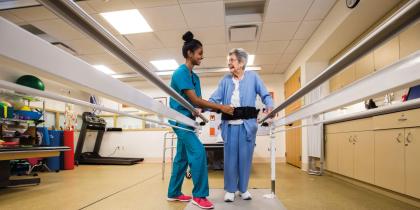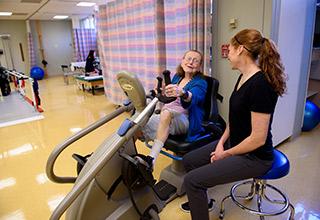How the Right Care After a Hip Fracture Can Help Prevent a Future Fall
Osteoporosis often goes undiagnosed until a fracture occurs — but even then, essential follow-up care is frequently overlooked.

Sometimes, what can seem like a minor fall turns out to be much more serious if that fall leads to a hip fracture. While you should take any fracture seriously, hip fractures specifically can set off a complicated recovery process.
Whether you have experienced a hip fracture or simply want to prevent one from happening, knowing the risk factors for osteoporosis and recovery tips can make a big difference in safeguarding your health.
When a hip fracture reveals bone loss
If someone falls from a standing height, like slipping in the bathroom, and breaks their hip, it’s not just bad luck. It’s likely the result of osteoporosis, a condition that weakens bones and makes them more likely to break from minor falls.
Hip fractures are often the first visible sign of bone loss. That’s because there are usually no symptoms in the early stages of osteoporosis.
Osteoporosis causes your bones to become weak and brittle over many years. It occurs when the breakdown of old bone exceeds the formation of new bone, leading to bone density and strength loss over time. You don’t feel your bones weakening, but that doesn’t mean it isn’t happening. That’s why osteoporosis is often called a “silent disease.”
Who is most at risk for osteoporosis and falls?
There are several factors that increase your risk of developing osteoporosis or experiencing a fall:
- Age: Osteoporosis becomes more common in older adulthood, with millions of people over 50 in the U.S. living with the disease.
- Sex: Women are four times more likely than men to develop osteoporosis, with risk rising after menopause.
- Chronic health conditions: Certain medical conditions, including thyroid disorders, celiac disease, cancer, and rheumatoid arthritis, can increase your risk of developing osteoporosis.
- Medications: Some medications can thin bones, lower blood pressure, and cause dizziness, increasing your risk of falling and breaking a bone. If you’re taking any medications for blood pressure, mood, or heart problems, talk to your doctor about whether they could increase your risk for fracture.
- Lifestyle factors: Inactivity and poor nutrition, especially diets low in calcium, protein, and vitamin D, can affect bone strength.
- Unsafe home environments: If your home has many obstacles, loose rugs, poor lighting, or lacks accessibility despite mobility issues, you could be at an increased risk for a fall.
Why are hip fractures so serious?
As we age, hip fractures are usually more than “just a broken bone.” That’s because the hip joint is crucial in supporting mobility and balance. If it’s damaged, it can affect everything from walking to getting out of bed.
Hip fractures almost always require surgery, which frequently means getting a hip replacement. That’s how a ripple effect of health challenges can start. Surgery comes with its own risks, especially for people with preexisting conditions or who are vulnerable to anesthesia. Post-operative complications aren’t uncommon. The Framingham Study found that the risk of death is especially high in the first six months following a second hip fracture, which occurred at a median age of 86 years old.
After surgery, people undergo a period of rehabilitation, often in a post-acute facility that is either standalone or part of a long-term care facility. Some people have difficulty returning to the level of independence they had before falling, but with the right supports, many regain strength and continue living active, engaged lives.
Preventing hip fractures
Preventing hip fractures is the best way to avoid the health impacts they can cause!
Some ways you may prevent hip fractures include:
- A regular exercise routine
- Proper nutrition, including getting enough calcium and vitamin D
- Medication management
- An annual eye exam
- Assessing your home for fall risks
Additionally, bone density tests, known as DXA scans, are generally recommended for women aged 65 and older and men aged 70 and older. Medicare Part B covers a DXA scan once every 24 months if you meet specific conditions. However, they remain underused in preventive care. If you haven’t experienced a fall but want to assess your risk, ask your primary care doctor about a bone density test.
The risk of a subsequent fracture
While preventing hip fractures is the best-case scenario, that’s not always possible. If you’ve already experienced a hip fracture, another overlooked area is preventing second hip fractures.
Many hip fracture patients only receive acute treatment, or treatment to fix the initial hip injury — hospitalization, surgery, and short-term rehabilitation. That means osteoporosis goes untreated. The result can be a second fall within a few years, often with even more serious complications. The Framingham Study found that 15% of people who fracture their hip will experience a second hip fracture within five years.
What should post-fracture care look like?
Bone health assessments like DXA scans should also be standard post-fracture care when available. Additionally, less than 20% of fracture patients receive prescription treatment for osteoporosis to prevent further fractures.
If you fractured your hip and only received acute care, advocating for follow-up care is one step you can take. What should you ask your doctor for? A good place to start includes:
- A bone density test
- A fall risk assessment
- A medication evaluation
However, recovery isn’t just about tests and assessments. Rehabilitation is key, too. Researchers at Hebrew SeniorLife played a pivotal role in a randomized clinical trial called Starting a Testosterone and Exercise Program After Hip Injury, or STEP-HI. This study focused on older women recovering from hip fractures. The goal was to explore whether adding testosterone gel to a strength training program could speed up recovery in women aged 65 and older.
While testosterone gel didn’t significantly improve outcomes, exercise beyond standard rehabilitation proved beneficial. Women who continued exercise for 24 weeks, even without testosterone, saw noteworthy improvements in walking distance and function. Strength training may play an essential role in your post-rehabilitative care.
Fracture Liaison Services offer high-quality care
The gold standard of post-fracture care is fracture liaison services. Fracture liaison services care for people with fragility fractures — a fall from standing height or less — and reduce their risk of subsequent fractures. They bridge the gap between acute fracture care and the long-term management of osteoporosis, coordinating care between primary and specialty care providers. Fracture liaison service programs reduce the incidence of a second fracture by 74% in patients’ first year after a fracture!
While they aren’t available everywhere in the United States, larger hospital systems often offer fracture liaison services. If you’re not part of a larger hospital system, you can ask your surgeon during your hospital stay about the best steps to ensure you receive the right treatment to prevent a second fracture.
Post-acute rehabilitation care at Hebrew Rehabilitation Center
If you or a loved one recently experienced a hip fracture, surgery is the likely next step. After surgery, inpatient post-acute rehabilitative care at Hebrew Rehabilitation Center in Boston or Dedham can help get you on the road to recovery.
Our patients receive 24/7 care, including access to specialists such as physical, occupational, and speech therapists, dieticians, and case managers. We’ll help you build a foundation to get you back to the highest level of safety and well-being possible!
Our admissions team is here to help you, whether you’re a potential patient, family member, or senior care professional. Contact Hebrew Rehabilitation Center or call 617-363-8372 today.
Blog Topics
Learn More
Post-Acute Rehabilitative Care
Hebrew Rehabilitation Center in Boston and at Newbridge on the Charles in Dedham, MA, offers specialized care to older adults recovering from a surgery, complex illness, or hospital stay.





